To find Catalcam, access Google
Maps and in the search engine type "Midyat, Turkey". From the centre of
Midyat, follow the main road north (the road goes through stunning
Hasankeyf on its way to Batman) for about 6 kms to a junction for
Dargecit on the right. Take the road to the right. After about 15 kms
you pass beside the pretty village of Izbirak. Continue for another 5
kms and a turning to the left leads to Catalcam, which is about 4 kms
from the main road. It is an asphalt road all the way from Midyat to
Catalcam. Public transport exists between Midyat and Dargecit and the
minibus driver will know where to drop you for Catalcam. It is a
relatively easy walk across undulating plateau from the main road to
Catalcam, but almost everyone with a motor vehicle will provide you with
a lift all or part of the way.
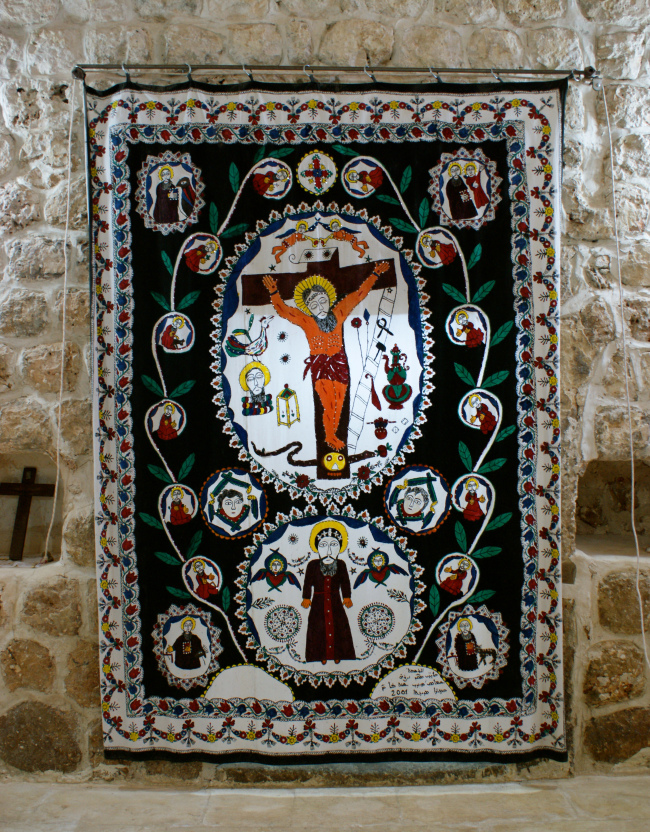
Catalcam is the Turkish name for a village known to Syriac [Assyrian] Christians as Dayro Daslibo. Nowadays, the monastery is, but for one or two nearby buildings, all that remains of the village (although later, when touring the monastery, I was told that Dayro Daslibo is really an abandoned village that exists just over the ridge).
From a distance of about 1 km, the monastic complex looks larger than some that remain in Tur Abdin, and its sturdy outer walls resemble those of a castle. It soon became apparent why it is so large and why it is protected by formidable walls. At times during the history of Dayro Daslibo, the monastery was also the village. For greater security houses were built within the complex, and evidence for such houses survives to this day.
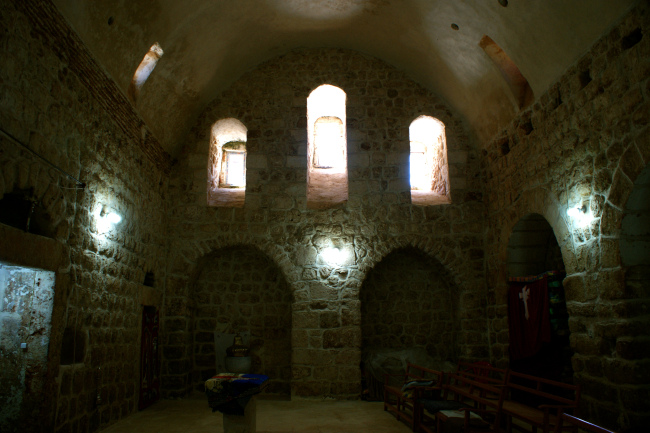
An elderly Syriac Christian who has lived in the village for most of his life, and a young Syriac Christian man whose family live in Sweden, led me on an astounding tour of the monastic complex. The elderly man knew a vast amount about the history and the folklore associated with the monastery, and the young Swedish-born Syriac Christian kindly translated what he could from Turoyo into English. At one point we stopped to drink coffee and eat a platter of fruit prepared by the young man's mother (the young man's family were living in the monastery for a month so they could re-engage with their roots). When I asked about sayfo (the large-scale massacre of Syriac Christians that began in April 1915), the elderly man told stories from those terrible times as if the events had happened only a few weeks' ago. It was obvious that sayfo (the year of the sword) has left an indelible mark on Syriac Christian consciousness, a mark comparable to the one that metz yeghem (the big calamity) has left on Armenian consciousness, and shoah (the holocaust) has left on Jewish consciousness.
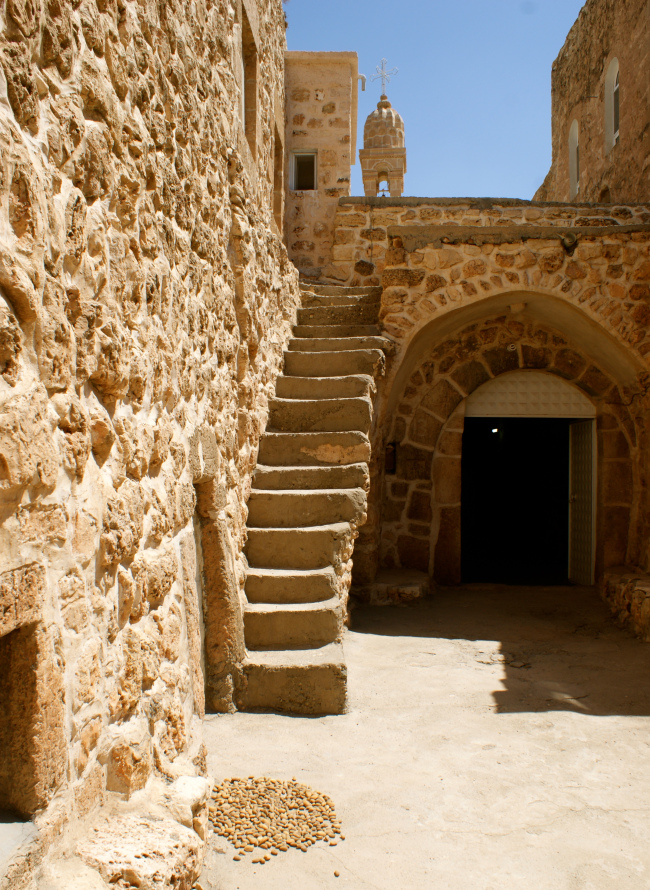
DelCogliano writes that:
"The monastery was founded by Mor Aho c. 575 -- 600 (the locals prefer an earlier foundation date of c. 500). Mor Aho was a native of Resh'aina (modern day Ra's al-Ain in Syria) and became a disciple of a local monk at the age of twelve. In 573 he was captured during a Persian raid and conscripted into the Persian army. Subsequently extricating himself, he returned to the Tur Abdin region and founded a monastery.
"Some time after this he travelled to Jerusalem and Constantinople from where he smuggled away a relic of the Holy Cross. Mor Aho hid the relic in a slit in his leg, which miraculously healed over the wound, demonstrating divine approbation of the theft. The monastery's main church, today dedicated to Mor Aho, was built over the relic, which was positioned in an undisclosed location (no doubt to prevent its further theft). Hence the relic cannot be seen and no one knows exactly where it is, though local tradition remains certain of its presence. Mor Aho is also responsible for the conversion of four villages in the area of Melitene (present-day Eski Malatya) and for the foundation of another monastery in the same region. He died at a great age, and his tomb can still be seen today in the monastery's Beth Qadishe.
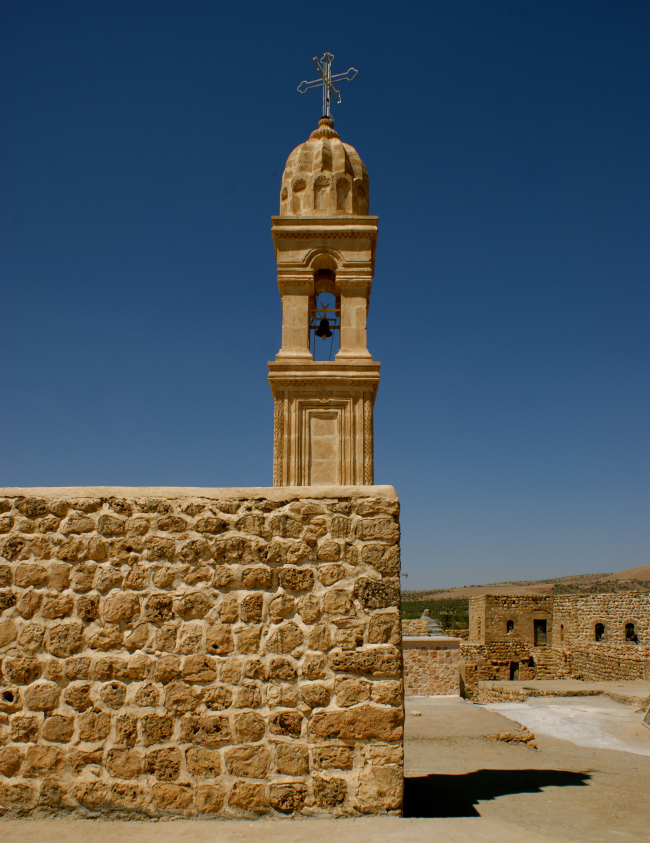
"Whatever its history after the death of Mor Aho, Dayro Daslibo was abandoned as a monastic site during the massacres of 1915. Subsequent attempts to revive monastic life failed, with some of the monks being killed. The situation of the village in the late 1990s was so precarious that in May 2000 Reverend Stephen Griffith wrote: '(The village of) Dayro Daslibo has only thirteen old people who are waiting to die. Their stories of the massacres of 1915 and 1924 are still vivid, but it is the migration of their children which will end the 1,400 year-old Christian history of the village.'
"The situation of Dayro Daslibo has improved since then. One family has returned to the village from the diaspora, a young man returned to the village after his military service, and the local community and visiting emigrants have expended much energy restoring and improving the church. A new well has been sunk for the village by the local authorities. Finally, a nun named Meryem (Mary) has lived at the monastery since 2001. She explained to us, however, that since there are no monks residing at the monastery and the liturgy is not performed on a regular basis, the Syriac Orthodox do not consider Dayro Daslibo an active monastery. Nonetheless, the presence of Meryem is perhaps a prelude to the full revival of monastic life. A visiting priest celebrates the liturgy every twenty or forty days for the five Christian families that now reside in the village.
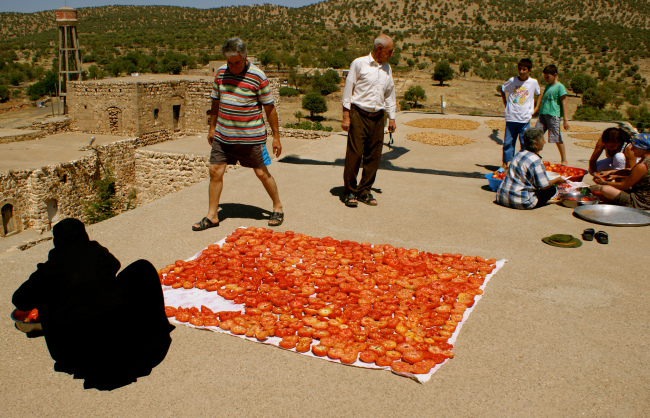
"When we visited Dayro Daslibo, the lively Meryem gave us a tour of the monastery, speaking to us in German… We were able to scan the magnificent horizon from atop the church, speaking also to a local woman as she dried tomatoes on the roof."
I also found myself on the roof of the church and can confirm that the views in every direction are excellent. On the occasion of my visit, female members of the family from Sweden helped a local woman to dry tomatoes. The women had a large plastic bowl full of enviably large tomatoes. They sliced the tomatoes in half. The sliced tomatoes were carefully arranged on a sheet of plastic or tarpaulin so that they did not touch their neighbours. The skins of the tomatoes were in contact with the plastic or tarpaulin, which meant that the juicy insides faced toward the sun. I was advised that, because of the extremely dry heat in August, it took only two to five days for the tomatoes to be ready for storage. Meryem arrived to check that everything was going well.
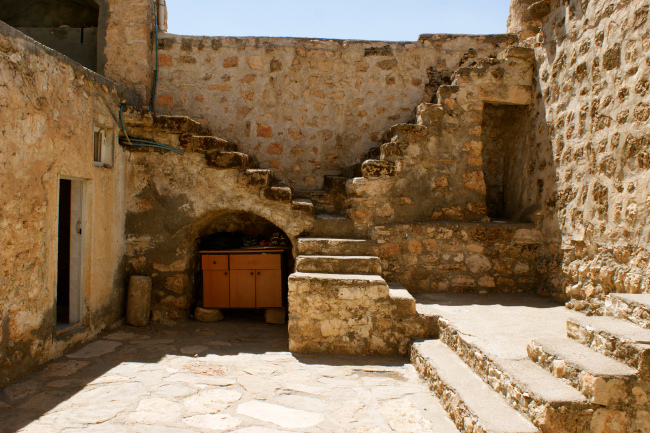
Sinclair writes that:
"The monastery was built round a court and surrounded by a high wall: the present villagers have built houses at first floor level and increased the place's fortress-like aspect. One church, however, that of Mor Aho, lies just outside the enclosure, s. of the se. corner. Mor Aho, who died in 556 (?), was the supposed founder of this monastery: in reality, the monastery was probably founded earlier…
"Church of the Cross. This lies against the e. wall near the s. end, and a chamber reached from the s. sanctuary touches the monastery's s. wall. The church is of the transverse nave type, and extends about 20 metres e. -- w. Houses have now been built over most of the roof, but a beth slutho (free-standing, open-air apse, probably for summer services) survives against the w. wall of the narthex. It is much rebuilt, fragments of sculpture being re-incorporated in random positions on all three sides… The beth slutho's inner end is rectangular rather than semi-circular. The narthex is now reached from a corridor to its n.: an opening has been broken into the narthex's n. end. The church, too, has been rebuilt at some stage, and there are signs of subsequent restoration. The middle sanctuary ends in a semi-circle which projects beyond the e. line of the two side sanctuaries.
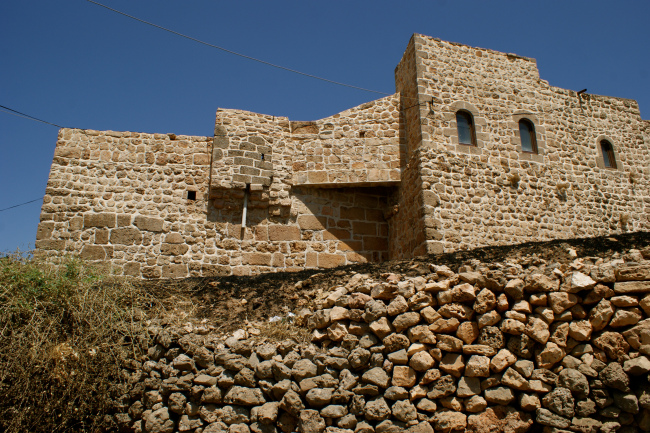
"Church of Mor Aho. The church, which has a square nave, lies at the n. end of the rectangular chamber for the saint's tomb, the latter chamber being larger overall and longer n. -- s. than the church's nave. A recent corridor has been created on the w., connecting the doors of both nave and tomb chamber, and the outer wall of the corridor has been continued round the other sides of the building as an encasing wall, though the church's three sanctuaries were rebuilt, and their layout changed, in the process. The church has kept its original wall (probably 556) on the w. and, in places, on the e., including the apse arch and the wall to its n.: the niche here seems to be the beginning of the original passage to the n. sanctuary, which is now reached from the middle sanctuary. The saint's bare tomb lies in the s. chamber's sw. corner. Parts at least, and probably the whole, of the chamber's walls, were rebuilt in 1034 (inscription on outer face of w. wall), and the church's n. wall seems to have been included in the renovation."
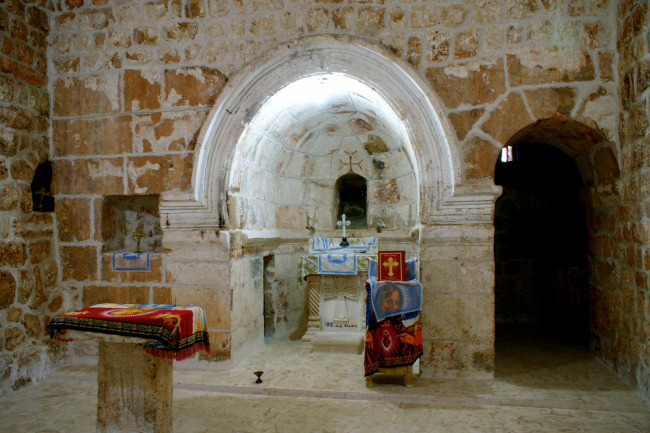
After we had looked around the Church of the Cross and the compound's other buildings, the latter including accommodation for Meryem, a few villagers and short- or long-term visitors (parts of the complex look and feel very old, which says a lot about how carefully restoration has been undertaken in recent times), we left the main entrance and walked to the left where an extension of the complex exists outside the walled enclosure.
Here is a second, smaller, church (the church that Sinclair identifies as that of Mor Aho) with a cemetery in front of it. The cemetery has many old graves and gravestones within it, but also, beneath two or three stunted trees, a handful of more recent graves covered with quite large tombs. That Syriac Christians are once more buried in Tur Abdin simply because of old age is itself a very positive sign.
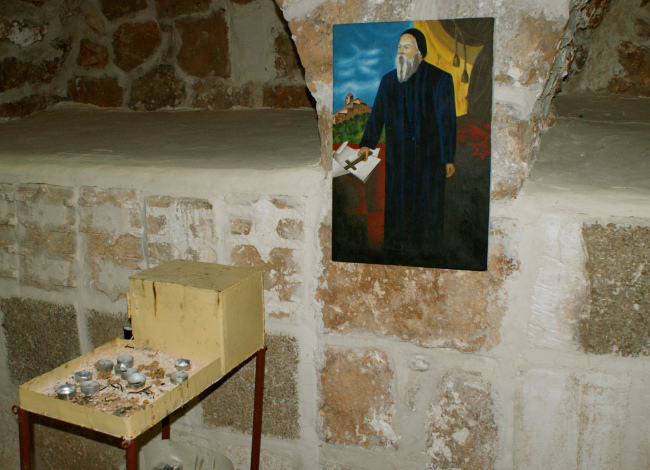
We entered the second church where my guides showed me a small flat cavity in the wall from where something had obviously been removed. My guides said that the cavity once held a stone inscribed with information in Aramaic (similar stones exist elsewhere in the church). However, the inscribed stone had caught the eye of an English or a European woman who, a few years before sayfo, had visited the monastery. The woman asked if she could have the inscribed stone and, so the story goes, the people who were showing her around granted her wish. Understandably, my guides were curious to know what had been written on the inscribed stone.
They did not want the inscribed stone returned because, according to local tradition, it had been given to the woman willingly, but they wanted to know what was written on it so that a replica could be carved and inserted into the cavity from where the original had been removed.
To the best of my knowledge, the only English or European woman who might have visited the monastery a few years before sayfo was Gertrude Bell (she visited Tur Abdin twice, in 1909 and 1911), so I said this to my guides. I also said that by typing "Gertrude Bell" into an internet search engine the remarkable Gertrude Bell archive in the possession of Newcastle University will instantly appear in the list of relevant websites. I said I would try to find information about the inscribed stone, but warned that such information might take time to track down.
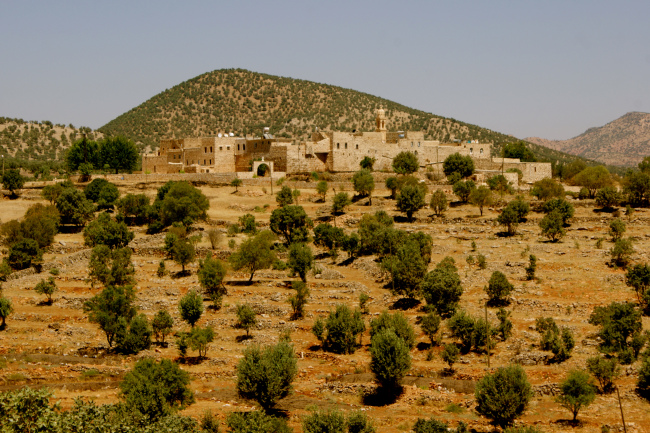
We went into the Beth Qadishe below the church where famous figures associated with the monastery lie buried, Mor Aho included, then we returned to the sun-swamped cemetery. I delayed my departure a few minutes more to take full stock of this remarkable monastic complex. For obvious reasons, Mor Gabriel Monastery (about 30 kms south-east of Midyat) and Dar Zafaran Monastery (about 6 kms east of Mardin) are more important and better known than the Monastery of the Holy Cross, but I found my visit to Dayro Daslibo highly instructive and very moving.
N.B. Here is some useful background information for teachers (and, indeed, others) who may wish to use the post for educational purposes.
The monastery featured in the photos below belongs to the Syriac Orthodox Church, a church which in the old days used to be misleadingly called "monophysite". The churches most often deemed "monophysite" (Christ has one nature, the divine) are the Armenian Apostolic, the Coptic, the Ethiopian Orthodox and the Syriac Orthodox churches. These churches are distinct from the "dyophysite/diaphysite" churches (the Protestant, the Roman Catholic and the "mainstream" Orthodox churches such as the Greek, the Russian and the Serbian Orthodox churches) which subscribe to the idea that Christ has two natures, the divine and the human.
However, the Armenian Apostolic, the Coptic, the Ethiopian Orthodox and the Syriac Orthodox churches are better described as "miaphysite". The "miaphysite" doctrine derives from Cyril of Alexandria who described Christ as being of one incarnate nature where both the divine and the human are united. While the prefix "mono" refers to a singular one, the prefix "mia" refers to a compound one.
The "dyophysite/diaphysite" concept of Jesus can be equated to a glass containing oil and water (the two natures, the divine and the human, are present in Jesus, but do not mix), while the "miaphysite" concept of Jesus can be equated to a glass containing wine and water (the two natures, the divine and the human, mix).
Along with the Coptic Church, the Syriac Orthodox Church played a key role in the development of early Christian monasticism.
The Syriac Orthodox Monastery of Mor Gabriel near Midyat, Turkey, can claim to be one of the oldest still functioning Christian monasteries in the world, roughly contemporary with the four ancient Coptic monasteries of Wadi al-Natrun, Egypt, whose origins also lie in the late 4th century. Mor Gabriel's foundation precedes Mar Saba Monastery in Palestine by about 80 years, Saint Catherine's Monastery immediately below Mount Sinai by about 150 years, and the earliest monastery on Mount Athos by at least 400 years. Thus, Mor Gabriel is one of a handful of monasteries carrying on a tradition that has continued, apart from periods of desertion, for over 1,600 years.
A brief word about the attractive sutore (the plural of suturo) d'madbho, or sanctuary veils (my thanks to DelCogliano for most of what follows). Suturo d'madbho is a type of artwork encountered all over Tur Abdin. Every Tur Abdin church has at least one suturo that separates the altar from the congregation at certain times during the liturgy. The suturo is attached to a curtain rod so that it can be easily drawn back and forth when necessary. Most churches also have several other sutore hanging on a bare wall or covering an alcove or doorway. Sutore are examples of a Turkish craft skill particularly popular in Anatolia called basmacilik, which literally means "stamping". The art of basmacilik involves taking wooden moulds carved into various figures and shapes, pressing them into paint, and then stamping the cloth with them. An alternative way of achieving the same outcome is to draw the outlines of the figures and the shapes on the cloth and then painting them by hand.
Most sutore are approximately 2 metres square. Each suturo has one or two large images in the centre of the cloth, typically of Mary, the last supper, the crucifixion or the resurrection. Almost without exception, in small circles at each of the four corners, are images of the four evangelists together with their symbols: John with an eagle, Matthew with a man, Mark with a lion and Luke with an ox. Other images include seraphim or angels. Figures on the sutore are usually surrounded by decorative floral arrangements or elaborate scrollwork. While some sutore are subdued in tone because of the use of different browns, many are bright and vibrant because they employ deep reds, blues, yellows and greens. Although most sutore in Tur Abdin are not very old, they appear to be based on designs from an earlier age.

Catalcam is the Turkish name for a village known to Syriac [Assyrian] Christians as Dayro Daslibo. Nowadays, the monastery is, but for one or two nearby buildings, all that remains of the village (although later, when touring the monastery, I was told that Dayro Daslibo is really an abandoned village that exists just over the ridge).
From a distance of about 1 km, the monastic complex looks larger than some that remain in Tur Abdin, and its sturdy outer walls resemble those of a castle. It soon became apparent why it is so large and why it is protected by formidable walls. At times during the history of Dayro Daslibo, the monastery was also the village. For greater security houses were built within the complex, and evidence for such houses survives to this day.

An elderly Syriac Christian who has lived in the village for most of his life, and a young Syriac Christian man whose family live in Sweden, led me on an astounding tour of the monastic complex. The elderly man knew a vast amount about the history and the folklore associated with the monastery, and the young Swedish-born Syriac Christian kindly translated what he could from Turoyo into English. At one point we stopped to drink coffee and eat a platter of fruit prepared by the young man's mother (the young man's family were living in the monastery for a month so they could re-engage with their roots). When I asked about sayfo (the large-scale massacre of Syriac Christians that began in April 1915), the elderly man told stories from those terrible times as if the events had happened only a few weeks' ago. It was obvious that sayfo (the year of the sword) has left an indelible mark on Syriac Christian consciousness, a mark comparable to the one that metz yeghem (the big calamity) has left on Armenian consciousness, and shoah (the holocaust) has left on Jewish consciousness.

"The monastery was founded by Mor Aho c. 575 -- 600 (the locals prefer an earlier foundation date of c. 500). Mor Aho was a native of Resh'aina (modern day Ra's al-Ain in Syria) and became a disciple of a local monk at the age of twelve. In 573 he was captured during a Persian raid and conscripted into the Persian army. Subsequently extricating himself, he returned to the Tur Abdin region and founded a monastery.
"Some time after this he travelled to Jerusalem and Constantinople from where he smuggled away a relic of the Holy Cross. Mor Aho hid the relic in a slit in his leg, which miraculously healed over the wound, demonstrating divine approbation of the theft. The monastery's main church, today dedicated to Mor Aho, was built over the relic, which was positioned in an undisclosed location (no doubt to prevent its further theft). Hence the relic cannot be seen and no one knows exactly where it is, though local tradition remains certain of its presence. Mor Aho is also responsible for the conversion of four villages in the area of Melitene (present-day Eski Malatya) and for the foundation of another monastery in the same region. He died at a great age, and his tomb can still be seen today in the monastery's Beth Qadishe.

"Whatever its history after the death of Mor Aho, Dayro Daslibo was abandoned as a monastic site during the massacres of 1915. Subsequent attempts to revive monastic life failed, with some of the monks being killed. The situation of the village in the late 1990s was so precarious that in May 2000 Reverend Stephen Griffith wrote: '(The village of) Dayro Daslibo has only thirteen old people who are waiting to die. Their stories of the massacres of 1915 and 1924 are still vivid, but it is the migration of their children which will end the 1,400 year-old Christian history of the village.'
"The situation of Dayro Daslibo has improved since then. One family has returned to the village from the diaspora, a young man returned to the village after his military service, and the local community and visiting emigrants have expended much energy restoring and improving the church. A new well has been sunk for the village by the local authorities. Finally, a nun named Meryem (Mary) has lived at the monastery since 2001. She explained to us, however, that since there are no monks residing at the monastery and the liturgy is not performed on a regular basis, the Syriac Orthodox do not consider Dayro Daslibo an active monastery. Nonetheless, the presence of Meryem is perhaps a prelude to the full revival of monastic life. A visiting priest celebrates the liturgy every twenty or forty days for the five Christian families that now reside in the village.

"When we visited Dayro Daslibo, the lively Meryem gave us a tour of the monastery, speaking to us in German… We were able to scan the magnificent horizon from atop the church, speaking also to a local woman as she dried tomatoes on the roof."
I also found myself on the roof of the church and can confirm that the views in every direction are excellent. On the occasion of my visit, female members of the family from Sweden helped a local woman to dry tomatoes. The women had a large plastic bowl full of enviably large tomatoes. They sliced the tomatoes in half. The sliced tomatoes were carefully arranged on a sheet of plastic or tarpaulin so that they did not touch their neighbours. The skins of the tomatoes were in contact with the plastic or tarpaulin, which meant that the juicy insides faced toward the sun. I was advised that, because of the extremely dry heat in August, it took only two to five days for the tomatoes to be ready for storage. Meryem arrived to check that everything was going well.

Sinclair writes that:
"The monastery was built round a court and surrounded by a high wall: the present villagers have built houses at first floor level and increased the place's fortress-like aspect. One church, however, that of Mor Aho, lies just outside the enclosure, s. of the se. corner. Mor Aho, who died in 556 (?), was the supposed founder of this monastery: in reality, the monastery was probably founded earlier…
"Church of the Cross. This lies against the e. wall near the s. end, and a chamber reached from the s. sanctuary touches the monastery's s. wall. The church is of the transverse nave type, and extends about 20 metres e. -- w. Houses have now been built over most of the roof, but a beth slutho (free-standing, open-air apse, probably for summer services) survives against the w. wall of the narthex. It is much rebuilt, fragments of sculpture being re-incorporated in random positions on all three sides… The beth slutho's inner end is rectangular rather than semi-circular. The narthex is now reached from a corridor to its n.: an opening has been broken into the narthex's n. end. The church, too, has been rebuilt at some stage, and there are signs of subsequent restoration. The middle sanctuary ends in a semi-circle which projects beyond the e. line of the two side sanctuaries.

"Church of Mor Aho. The church, which has a square nave, lies at the n. end of the rectangular chamber for the saint's tomb, the latter chamber being larger overall and longer n. -- s. than the church's nave. A recent corridor has been created on the w., connecting the doors of both nave and tomb chamber, and the outer wall of the corridor has been continued round the other sides of the building as an encasing wall, though the church's three sanctuaries were rebuilt, and their layout changed, in the process. The church has kept its original wall (probably 556) on the w. and, in places, on the e., including the apse arch and the wall to its n.: the niche here seems to be the beginning of the original passage to the n. sanctuary, which is now reached from the middle sanctuary. The saint's bare tomb lies in the s. chamber's sw. corner. Parts at least, and probably the whole, of the chamber's walls, were rebuilt in 1034 (inscription on outer face of w. wall), and the church's n. wall seems to have been included in the renovation."

After we had looked around the Church of the Cross and the compound's other buildings, the latter including accommodation for Meryem, a few villagers and short- or long-term visitors (parts of the complex look and feel very old, which says a lot about how carefully restoration has been undertaken in recent times), we left the main entrance and walked to the left where an extension of the complex exists outside the walled enclosure.
Here is a second, smaller, church (the church that Sinclair identifies as that of Mor Aho) with a cemetery in front of it. The cemetery has many old graves and gravestones within it, but also, beneath two or three stunted trees, a handful of more recent graves covered with quite large tombs. That Syriac Christians are once more buried in Tur Abdin simply because of old age is itself a very positive sign.

We entered the second church where my guides showed me a small flat cavity in the wall from where something had obviously been removed. My guides said that the cavity once held a stone inscribed with information in Aramaic (similar stones exist elsewhere in the church). However, the inscribed stone had caught the eye of an English or a European woman who, a few years before sayfo, had visited the monastery. The woman asked if she could have the inscribed stone and, so the story goes, the people who were showing her around granted her wish. Understandably, my guides were curious to know what had been written on the inscribed stone.
They did not want the inscribed stone returned because, according to local tradition, it had been given to the woman willingly, but they wanted to know what was written on it so that a replica could be carved and inserted into the cavity from where the original had been removed.
To the best of my knowledge, the only English or European woman who might have visited the monastery a few years before sayfo was Gertrude Bell (she visited Tur Abdin twice, in 1909 and 1911), so I said this to my guides. I also said that by typing "Gertrude Bell" into an internet search engine the remarkable Gertrude Bell archive in the possession of Newcastle University will instantly appear in the list of relevant websites. I said I would try to find information about the inscribed stone, but warned that such information might take time to track down.

We went into the Beth Qadishe below the church where famous figures associated with the monastery lie buried, Mor Aho included, then we returned to the sun-swamped cemetery. I delayed my departure a few minutes more to take full stock of this remarkable monastic complex. For obvious reasons, Mor Gabriel Monastery (about 30 kms south-east of Midyat) and Dar Zafaran Monastery (about 6 kms east of Mardin) are more important and better known than the Monastery of the Holy Cross, but I found my visit to Dayro Daslibo highly instructive and very moving.
N.B. Here is some useful background information for teachers (and, indeed, others) who may wish to use the post for educational purposes.
The monastery featured in the photos below belongs to the Syriac Orthodox Church, a church which in the old days used to be misleadingly called "monophysite". The churches most often deemed "monophysite" (Christ has one nature, the divine) are the Armenian Apostolic, the Coptic, the Ethiopian Orthodox and the Syriac Orthodox churches. These churches are distinct from the "dyophysite/diaphysite" churches (the Protestant, the Roman Catholic and the "mainstream" Orthodox churches such as the Greek, the Russian and the Serbian Orthodox churches) which subscribe to the idea that Christ has two natures, the divine and the human.
However, the Armenian Apostolic, the Coptic, the Ethiopian Orthodox and the Syriac Orthodox churches are better described as "miaphysite". The "miaphysite" doctrine derives from Cyril of Alexandria who described Christ as being of one incarnate nature where both the divine and the human are united. While the prefix "mono" refers to a singular one, the prefix "mia" refers to a compound one.
The "dyophysite/diaphysite" concept of Jesus can be equated to a glass containing oil and water (the two natures, the divine and the human, are present in Jesus, but do not mix), while the "miaphysite" concept of Jesus can be equated to a glass containing wine and water (the two natures, the divine and the human, mix).
Along with the Coptic Church, the Syriac Orthodox Church played a key role in the development of early Christian monasticism.
The Syriac Orthodox Monastery of Mor Gabriel near Midyat, Turkey, can claim to be one of the oldest still functioning Christian monasteries in the world, roughly contemporary with the four ancient Coptic monasteries of Wadi al-Natrun, Egypt, whose origins also lie in the late 4th century. Mor Gabriel's foundation precedes Mar Saba Monastery in Palestine by about 80 years, Saint Catherine's Monastery immediately below Mount Sinai by about 150 years, and the earliest monastery on Mount Athos by at least 400 years. Thus, Mor Gabriel is one of a handful of monasteries carrying on a tradition that has continued, apart from periods of desertion, for over 1,600 years.
A brief word about the attractive sutore (the plural of suturo) d'madbho, or sanctuary veils (my thanks to DelCogliano for most of what follows). Suturo d'madbho is a type of artwork encountered all over Tur Abdin. Every Tur Abdin church has at least one suturo that separates the altar from the congregation at certain times during the liturgy. The suturo is attached to a curtain rod so that it can be easily drawn back and forth when necessary. Most churches also have several other sutore hanging on a bare wall or covering an alcove or doorway. Sutore are examples of a Turkish craft skill particularly popular in Anatolia called basmacilik, which literally means "stamping". The art of basmacilik involves taking wooden moulds carved into various figures and shapes, pressing them into paint, and then stamping the cloth with them. An alternative way of achieving the same outcome is to draw the outlines of the figures and the shapes on the cloth and then painting them by hand.
Most sutore are approximately 2 metres square. Each suturo has one or two large images in the centre of the cloth, typically of Mary, the last supper, the crucifixion or the resurrection. Almost without exception, in small circles at each of the four corners, are images of the four evangelists together with their symbols: John with an eagle, Matthew with a man, Mark with a lion and Luke with an ox. Other images include seraphim or angels. Figures on the sutore are usually surrounded by decorative floral arrangements or elaborate scrollwork. While some sutore are subdued in tone because of the use of different browns, many are bright and vibrant because they employ deep reds, blues, yellows and greens. Although most sutore in Tur Abdin are not very old, they appear to be based on designs from an earlier age.






No comments:
Post a Comment